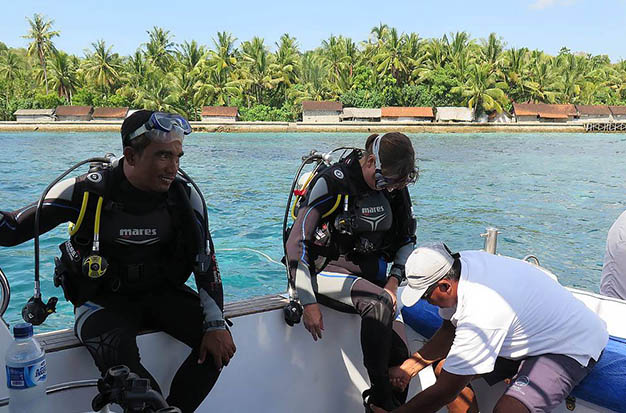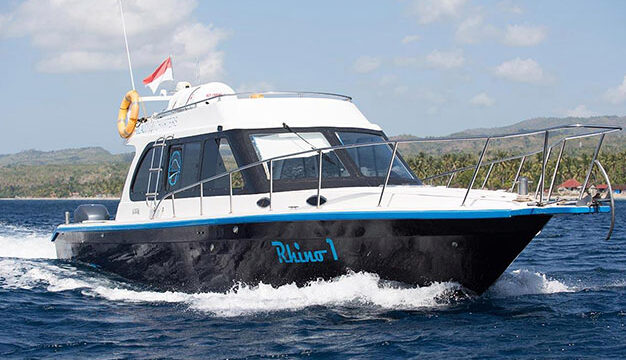A dive boat is the stuff of dreams. The way we see it, at least.
Diving from a boat is enjoyable and simple. However, we frequently don’t have a lot of information about them. What varieties of dive boats are available, the rules on board, instructions for diving from a dive boat, and the amenities you can anticipate on a dive boat.
To guarantee an enjoyable trip and an excellent diving experience, we take into account all aspects of scuba dive boats. Let’s go, Captain, full speed!
What Is A Dive Boat?
A dive boat is a boat that recreational divers or professional scuba divers use to reach a dive site which they could not conveniently reach by swimming from the shore. Dive boats can be moved by wind or human power, but they are typically propelled by internal combustion engines. All dive boats have some features in common, like easy access from the water, but some features are only applicable in certain situations or regions. If the vessel is already usable, it can be used without much adaptation or it can be heavily modified to make it fit for purpose.
Divers and their equipment may be simply transported to and from the dive site by dive boats, or they may offer longer-term support and shelter for day trips or periods spanning several days.[1] Diver deployment can occur while a boat is moored, at anchor, or while underway. This practice is referred to as live-boating or live-boat diving. Boat diving involves a variety of specialized techniques, such as water entry and exit, avoiding injury to the dive boat, and keeping the dive boat crew informed of the divers’ whereabouts in the water.
The boat crew also follows certain procedures to protect the divers from harm while they are underwater, track their whereabouts while they are diving, call them back if something happens, and make sure that no one is left behind.
Types Of Dive Boats
- Inflatable motorized dive boats
There are various sizes, and the majority can be moved by road as well. The majority of them are not diving boats, despite the fact that they are used for diving. A cylinder holder is included in pneumatic dive boats with tank attachments. Although they are quick and maneuverable, they lack seats. Instead, the divers sit on the inflated tubes, so they must remain in this position the entire trip.
Scuba divers back roll into the water and fin out, pulling themselves back onto the boat.
- Rigid hull covered diving boats
These boats range in size from 60 to 90 feet (18 to 27 meters) and are professionally manned.
- Liveaboard dive boats
Large diving ships called “liveaboard” dive boats offer all the amenities of a hotel, including food and lodging. In addition to a guide on board, they have a dive compressor to fill the tanks. They travel to the various dive sites.

Do’s And Don’ts Onboard A Dive Boat
Even if there is only one crew member, follow their instructions. Or perhaps there’s a small army on board.
In any case, pay attention to their instructions because they are more knowledgeable about not only how the boat operates but also how to read the weather and modify the dive plan accordingly.
Keep Your Dive Gear In One Place
Do keep your belongings hidden. Despite their size, boats are small. At least, they aren’t very big in comparison to the clientele they serve.
Most likely, you will be given a spot that is “yours” when you board the dive boat. Keep to it, and make sure everything is kept organized and in its place in your area.
By doing this, accidents involving the wrong equipment being grabbed or injuries caused by heavy weight belts falling on people’s feet are avoided. If you aren’t given a space, find out where the crew would prefer you to set up shop.
Do Button The Hatches
An idiom from the sea that has been around for a while. Make sure to secure everything with straps or store it in the proper places. Things can fall down, overboard, or even land on someone’s feet when a boat is in motion at sea.
Both bad for them and bad for your dive equipment.
Don’t Get In The Crew’s Way
This is particularly true whenever the boat is docked at the dive site or entering or exiting a harbor.
The crew might have to move around the boat a lot. You must therefore pay extra attention to staying in your designated area at this time. Or any “lounging” areas that you might have been told to remain in.
However, let the crew run the show and lend a hand if you can. They are skilled at what they do. Also keep in mind that while they are working, you are only there for entertainment.
Do Time Your Gear Assembly
Frequently, not everybody can be fully prepared at once, especially in small boats where space can be constrained.
Assemble your scuba unit well in advance to ensure it’s ready, unless the crew has specified otherwise. Once you arrive at the dive site, postpone donning your suit.
Put on your scuba unit and the other required items just before it’s time to enter the water. Then go scuba diving.
Do Take Note Of Your Boat
Take down any information that can help you identify the dive boat you just left.
Make a note of any distinguishing characteristics because this might be harder than you think. Do not forget to search for any markings that the boat crew may have left behind, such as flags, snaplights, or other similar devices.
Do Make Your Presence Known
Make sure the crew is informed when you return to the ship. Like the dive boat captain I once heard: “captaining a dive boat is stressful, because it is one of the few types of vessels where the passengers habitually fall overboard!”
Your return will be made safely, as the boat crew is now in charge. This means that whenever you’re in the water, they’ll unavoidably experience a little bit of stress until everyone is safely back aboard.
By explicitly letting them know when you will return, you can make their lives easier. And pay close attention whenever the crew conducts a roll call or head count.
On A Boat, How Do You Dive?
A crucial part of the journey is getting into the water from the dive boat. To do this safely, make sure no one is in the water directly beneath you. Above all, abide by the earlier described procedures, and move only when instructed to do so by staff.”. This coordinated action is necessary for safety reasons, so do it. neither too soon nor too late.
Once you’re in the water, move away from the boat quickly so that the following diver can enter without hurting you.
You return to the dive boat after the dive is complete. Recheck your gear carefully if you plan to take a second dive.
Boat drift dives occur as follows at Dressel Divers
In general, there are two approaches to drift diving. The group moves down a line that is connected to a buoy with the first. Until everyone can begin to move forward, the entire group holds onto it. The dive guide unfolds his SMB at the conclusion of the dive. Once it sees the buoy, the boat, which will have followed the group’s bubbles, knows the precise pick-up location.
In the second scenario, the guide jumps in first, and the group forms a circle around him to follow him during the descent and drift dive. The SMB is sent up if a couple needs to ascend early in order to protect them and signal the boat, and the boat will follow the bubbles on the surface. When everyone has ascended together, the divers are all brought up to the surface and picked up by the boat.
As with a regular dive, our attention is on navigation. A thorough control pressure should also be in place. When diving to a depth of 20 meters (65 feet), the ascent should begin at a pressure of about 50 bar (725 psi) and end at 35 bar (500 psi) on the surface.
Tips For All Dive Boats
- Take only what you need; even large boats have a limited amount of room. Bring a “save-a-dive” kit with you (there are no stores at sea), and make sure everything is packed and functional before you leave. Always keep your gear organized and securely fastened to avoid damage or injury; a clean boat is a safe boat!
- Be punctual and obtain authorization before boarding. Be sure to pay attention to the crew’s instructions, boat and dive briefings, roll call procedures, smoking bans, and information about local cultures and customs (like what to wear).
- Interact with the guides and crew; they will be happy to answer your questions, share their local expertise, and lend a helping hand if you’re not familiar with boats. Just keep out of their way if they’re mooring or picking up divers!
- Keep away from the propeller and don’t go in the water unless the crew says to. After surfacing, you can return safely by using a DSMB and noting the flags or signs that identify your boat. Not having to swim back to shore is one of the benefits of boat diving, but be sure to keep an eye out for the boat as it comes to pick you up!
- Try some shorter trips first if you’ve never been on a boat. Stay hydrated, get plenty of rest, keep your eyes on the horizon, and get plenty of fresh air mid-ship (where movement is less) if you’re feeling seasick. DAN has more advice here. Before taking any anti-seasickness medication, make sure it is safe for divers.

